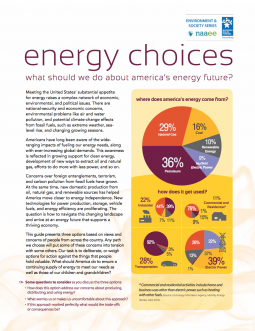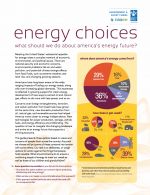
What Should We Do About America's Energy Future?
Meeting the United States’ substantial appetite for energy raises a complex network of economic, environmental, and political issues. There are national-security and economic concerns, environmental problems like air and water pollution, and potential climate-change effects from fossil fuels, such as extreme weather, sea- level rise, and changing growing seasons.
Americans have long been aware of the wide- ranging impacts of fueling our energy needs, along with ever-increasing global demands. This awareness is reflected in growing support for clean energy, development of new ways to extract oil and natural gas, efforts to do more with less power, and so on.
Concerns over foreign entanglements, terrorism, and carbon pollution from fossil fuels have grown. At the same time, new domestic production from oil, natural gas, and renewable sources has helped America move closer to energy independence. New technologies for power production, storage, vehicle fuels, and energy efficiency are proliferating. The question is how to navigate this changing landscape and arrive at an energy future that supports a thriving economy.
This guide presents three options based on views and concerns of people from across the country. Any path we choose will put some of these concerns into tension with some others. Our task is to deliberate, or weigh options for action against the things that people hold valuable. What should America do to ensure a continuing supply of energy to meet our needs as well as those of our children and grandchildren?
This issue guide placemat presents three options for deliberation:
Option 1: Keep America Self-Reliant and Stable
We should use our own abundant natural resources to produce all the energy we need to fuel our economy and avoid entanglements in unstable and unfriendly regions. Relying on the market and technological advancements will continue to lead us to a cleaner energy future, BUT large-scale energy production, even solar and wind power, has major environmental impacts, and unfairly affects communities near facilities like mines, refineries, and transmission lines. Furthermore, the transition to cleaner energy may not occur quickly enough to stave off the threat of climate change.
Option 2: Take Local Responsibility for Clean Energy
If we want our country to transition to clean, low-carbon power, everyone needs to participate, as not only a consumer but also a producer. Currently, most of the electricity in our system flows one way, from large power plants through transmission and distribution lines to end users. We need to decentralize that system to enable more clean, locally produced energy to ow where it is needed, BUT retooling our power grid and fueling infrastructure could be costly, take a long time, and cause economic disruptions. This would change how our communities look and how we live, and add a responsibility for producing power, which people may not want or be able to afford.
Option 3: Find Ways to Use Less Energy
We should aggressively reduce energy use and boost efficiency. Energy consumption in the United States has leveled off recently, but to tackle climate change, we must rapidly reduce carbon emissions. Using less energy could also lead to greater security, BUT requiring energy conservation could restrict personal choices and limit economic growth. And tackling climate change could depend more on replacing fossil fuels with cleaner fuels than on how much energy we use.


